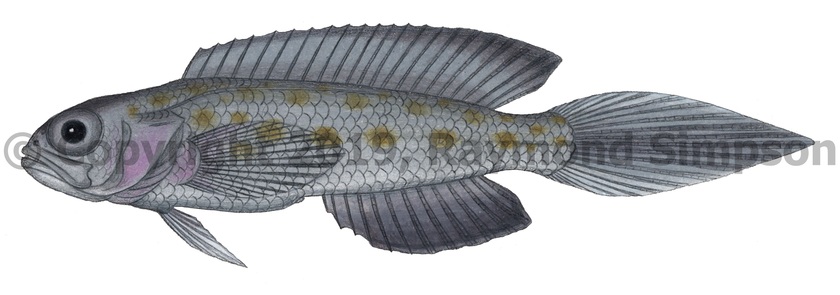
Common Name
Ghost Jawfish
Year Described
Myers, 1935
Identification
Dorsal Fin: X-XI, 11-12
Anal Fin: III, 10-12
Pectoral Fin: 19-21
Gill Rakers: 38-50 total on first arch
Vertebrae: 10+16-17 caudal
Lateral Scales: 26-33
Body elongate, gracile and compressed (characteristic of Lonchopisthus). Body tapers toward tail. Head large and round with a very large eye. Maxilla extends past eye and has a strong concave rear margin forming a distinct hook. Dorsal fin long with no notch between spiny and soft portions. Pelvic fin short (up to 30% SL) with first two rays thickened and unbranched and last three rays branched. Caudal fin lanceolate with central rays much longer than top and bottom. Branched caudal rays 10-13. Body scaled. Cheek and opercle with 4-5 rows of scales. Lateral line ends under first dorsal ray.
Color
Body described as silvery gray with green blotches on the body. Cheek and pectoral base pinkish. Bases of fins body colored with dark to black margins. Some preserved specimens have a spot between spines 4-7. Membranes on maxilla and premaxilla without dark pigment.
Size
Specimens range from 23-79mm SL.
Habitat
A deepwater jawfish living on the bottom(106-375m).
Range
S. Caribbean Sea (Honduras, Jamaica, Antilles, Panama to Venezuela) to northeastern and southern Brazil.
References
Smith-Vaniz, W.F. & S.J. Walsh. 2017. Revision of the jawfish genus Lonchopisthus with description of a new Atlantic species (Teleostei: Opistognathidae). Journal of the Ocean Science Foundation, 28, 52-89.
Other Notes
Closely related to Lonchopisthus ancistrus but differs in several aspects of morphology (cheek scales, pelvic fin length, etc.) and also color pattern. Other species in the genus have much higher meristics.
Lonchopisthus meadi, described from southern Brazil, is considered a synonym based on having no diagnostic morphological differences from L. lemur. However, given the distribution pattern is similar to other Caribbean-Brazil sister species pairs, genetic data and coloration data is needed to see if the disjunct Brazilian population is distinct.